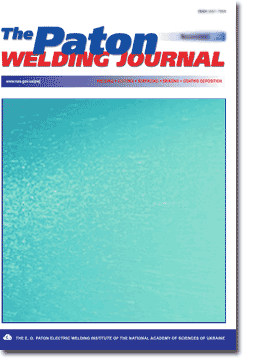

|
CONTRACTION OF THE WELDING ARC CAUSED BY THE FLUX IN TUNGSTEN-ELECTRODE
ARGON-ARC WELDING B.E. PATON, V.N. ZAMKOV, V.P. PRILUTSKY and P.V. PORITSKY |
5 |
| The theoretical model developed to describe contraction of the arc by flux allows for the processes occurring at the anode, variations in thermal conductivity of the arc gas and phenomena taking place on the arc column periphery, and establishes their analytical relationship with size of the conducting arc plasma column and the anode spot. Distribution of current density in the anode spot determined by analytical calculations using the said model is close to that determined by experimental measurements. | |
|
PRODUCTION AND WELDING OF HIGH-TEMPERATURE COMPOSITE
MATERIALS (Review) V.R. RYABOV |
12 |
| Peculiarities of composite materials (CM) on base of nickel, chromium and cobalt alloys, designed for operation at elevated temperatures, are considered. The methods of CM producing are described and different examples of manufacture of weldments are given. | |
|
PREHEATING AND POSTWELD HEATING IN WELDING HIGH-STRENGTH
ALLOYED STEELS L.I. MIKHODUJ and S.B. KASATKIN |
20 |
| The investigation showed that in welding of microalloyed steels it is necessary to limit the preheating temperature Tmax ~80?130 C and, when possible, to decrease the duration of effect of this temperature on welded joints. The postweld heating can be eliminated from the technological process. | |
|
ADHESION OF TITANIUM PARTS TO STEEL FIXTURE DURING
DIFFUSION BONDING S.N. FYODOROV, A.V. BONDAR, V.V. PESHKOV and V.V. SHURUPOV |
23 |
| The influence
of temperature and welding time on the strength of adhesion of steel 20
and 12Kh18N10T to VT6 titanium alloy is considered. Comparison of the results
of static rupture tests with the topography of the fracture surface of the
adhesion regions and their phase composition allows stating that in contact
interaction of VT6 alloy with steel 20 the titanium surface is blocked by
carbide-containing films, which prevents development of the adhesion process.
Therefore, in diffusion bonding of titanium structures, it is recommended
that fixture should be made from low-carbon steels. |
|
|
SOLDERS OF THE Sn --Ni--Ge SYSTEM FOR VACUUM SOLDERING V.F. KHORUNOV, V.I. SHVETS, G.N. GORBAN and L.K. DOROSHENKO |
27 |
| Tin-rich alloys of the Sn<196>Ni<196>Ge system used as solders show promise for erection-assembly and repair operations conducted in the orbit. Results of investigations into microstructure, phase composition, melting temperature ranges, operational and strength properties of alloys, which served as the basis for selection of a range of optimal solder compositions, are presented. Examples of practical application of the solders for the fabrication of truss structures are given. | |
|
ABILITY TO RESTORE COATINGS UNDER THE ACTUAL CONDITIONS
OF SPACE B.E. PATON, E.S. MIKHAILOVSKAYA, V.F. SHULYM, A.A. ZAGREBELNII, V.P. NIKITSKII, I.V. CHYRILO and L.O. NEZNAMOVA |
32 |
| To increase the service life of expensive space vehicles it is worthy while to pay attention to testing the equipment and technology for deposition of coatings under the conditions of the object service. The application of the electron beam technology as most feasible under the space conditions is considered. The quality of coatings and methods of technology realization are evaluated. | |
|
IMPROVEMENT OF ARC WELDING USING ELECTROMAGNETIC
METHODS S.V. PUSTOVOIT and G.I. LESKOV |
38 |
| It is established that the electromagnetic force, which acts to the front part of the pool, is sufficient for displacement of pool metal to a tail part and greatly influences the penetration depth. | |
|
TECHNOLOGICAL CAPABILITIES OF THE PROCESS OF DOUBEL-SIDED
WELDING OF ALUMINIUM ALLOYS A.Ya. ISHCHENKO, N.M. VOROPAI, V.P. BUDNIK and V.A. MISHENKOV |
42 |
| Features of TIG-welding of aluminium alloys by arcs facing each other were studied. Compared to the regular processes which envisage weld formation from one side, an essential increase of metal penetration has been achieved with the weld width comparable with the base metal thickness and a favourable appearance of the weld from both sides of the joint. | |
|
PLASMA SURGICAL SYSTEM «PLASMAMED» B.E. PATON, V.S. GVOZDETSKY, V.I. DRANOVSKY, V.L. DZHEPPA, Yu.S. FURMANOV and A.A. LYASHENKO |
45 |
| Decribed are the basic results of the development made by the State Design Bureau «Yuzhnoye» in collaboration with the E.O. Paton Electric Welding Institute and the Institute for Experimental and Clinical Surgery. The development included the plasma surgical system «Plasmamed» intended for surgical operations, such as dissection of biological tissues (destruction) and arrest of bleeding on injured surfaces (coagulation). | |
|
ADVANCED MEANS OF TRAPPING AND NEUTRALIZING TOXIC
GASEOUS SUBSTANCES IN WELDING PRODUCTION A.A. ENNAN and T.L. RAKITSKAYA |
47 |
| The feasibility of trapping welding aerosol (WA) to prevent the respiratory organs of welders is considered conceptually. The peculiarities of neutralizing different types of WA are analyzed. The information about the new multicomponent catalysts for neutralizing WA and technology of their production are given. | |
|
FOAM ALUMINIUM AS A NEW SUPER LIGHT-WEIGHT MATERIAL.
PROSPECTS FOR ITS USE IN WELDED STRUCTURES A.A. BONDAREV, N.G. TRETYAK, Andr.A. BONDAREV, V.P. BUDNIK and L.A. ARBUZOVA |
51 |
| The properties of a new material, namely foam aluminium are given. The areas of its rational use are determined. Concrete examples are cited to show the possibility, in principle, of application of foam aluminium in welded structures, when various welding procedures are used. | |
|
PLASMATRONS FOR POWDER SPRAYING OF COATINGS V.L. DZYUBA, ODE HALIL ABU DARVISH and S.N. SERGIENKO |
54 |
| Peculiarities of design and service characteristics of plasmatrons for powder spraying and dispersion are presented. Basic parameters of the plasmatrons are estimated. | |
| ADVERTISING | 56 |
(You are viewing the simplified file contents)
Sorry, the PDF of this issue is not yet available
The cost of subscription/purchase order journals or individual articles
| Journal/Currency | Annual Set | 1 issue printed |
1 issue |
one article |
| TPWJ/USD | 384 $ | 32 $ | 26 $ | 13 $ |
| TPWJ/EUR | 348 € | 29 € | 24 € | 12 € |
| TPWJ/UAH | 7200 UAH | 600 UAH | 600 UAH | 280 UAH |
| AS/UAH | 1800 UAH | 300 UAH | 300 UAH | 150 UAH |
| AS/USD | 192 $ | 32 $ | 26 $ | 13 $ |
| AS/EUR | 180 € | 30 € | 25 € | 12 € |
| SEM/UAH | 1200 UAH | 300 UAH | 300 UAH | 150 UAH |
| SEM/USD | 128 $ | 32 $ | 26 $ | 13 $ |
| SEM/EUR | 120 € | 30 € | 25 € | 12 € |
| TDNK/UAH | 1200 UAH | 300 UAH | 300 UAH | 150 UAH |
| TDNK/USD | 128 $ | 32 $ | 26 $ | 13 $ |
| TDNK/EUR | 120 € | 30 € | 25 € | 15 € |
AS = «Automatic Welding» - 6 issues per year;
TPWJ = «PATON WELDING JOURNAL» - 12 issues per year;
SEM = «Electrometallurgy Today» - 4 issues per year;
TDNK = «Technical Diagnostics and Non-Destructive Testing» - 4 issues per year.


